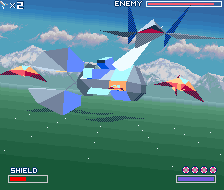any game at 60fps
the game

!gaming is a community for gaming noobs through gaming aficionados. Unlike !games, we don’t take ourselves quite as serious. Shitposts and memes are welcome.
1. Keep it civil.
Attack the argument, not the person. No racism/sexism/bigotry. Good faith argumentation only.
2. No sexism, racism, homophobia, transphobia or any other flavor of bigotry.
I should not need to explain this one.
3. No bots, spam or self-promotion.
Only approved bots, which follow the guidelines for bots set by the instance, are allowed.
4. Try not to repost anything posted within the past month.
Beyond that, go for it. Not everyone is on every site all the time.
Logo uses joystick by liftarn
any game at 60fps
the game

Any true 2D game, because the console was designed for 2D games. The SuperFX chip used for Star Fox was also used for Yoshi's Island, which did maintain 60Hz.
Yeah? Well that's like 40 triangles!
And this required an extra in-cartridge hardware to render it
I can hear this image. Starfox OST is the shit.
Do a bagel roll.
What's neat is that you don't remember old games looking like this. You remember them looking great, because your imagination filled in the gaps.
To be fair, the soft edges of CRTs were much more forgiving when viewing chunky pixels.
SNES resolution was 256 x 224 with a 15 bit colour. You're using your chrome on a 3,840 x 2,160 screen with a 32 bit colour. That's 308x more data per frame to render. You should be really impressed that in a span of just three decades we got 300x improvement in performance.
Someone clearly didn't play SNES games on the original hardware.
Yeah, slowdowns, choppy graphics, and other glitches to be had.
It's almost like having double frame buffers for 720p or larger, 16 bit PCM audio, memory safe(ish) languages, streaming video, security sandboxes, rendering fully textured 3d objects with a million polygons in real time, etc. are all things that take up cpu and ram.
I didn’t realize web browsing in Chrome required fully textured 3D objects. Not to mention playing 720p video with PCM audio in a separate app doesn’t grind everything to a halt.
well the gpu doesn't care if it's 2d or 3d, but you are rendering a whole bunch of textured triangles.... (separated into tiles for fast partial or multithreaded re-rendering), and also just-in-time rasterizing fonts, running a complex constraint solver to lay out the ui, parsing 3 completely separate languages, communicating using multiple complex network protocols, doing a whole bunch interprocess communication in order to sandbox stuff
I will run any game at 60fps if it was designed for this exact machine that does nothing but play games designed for it and is also 16-bit with pixel graphics and also has low quality audio and also fits in the memory of the cartridge
Are you talking about games? There, it's mostly textures.
Web, that's a whole other story, why it uses so much RAM.
WebGL means the browser has access to the GPU. Also, the whole desktop tends to be rendered as a 3D space these days. It makes things like scaling and blur effects easier, among other benefits.
"Any SNES game" is pretty much just F-ZERO.
Actually, fun fact: F-ZERO runs at a locked 60FPS for every single release. SFC, N64, GBA and GC. It's some really impressive stuff for N64.
I have a ThinkPad T61, a laptop from 2007, with only 4 GB of RAM. I can open Firefox with 10 tabs, including a Youtube video at 480p, and still have 1GB of RAM left. Yet people act like 8GB is unusable these days.
If we need to get into this kind of debate; may i remember everyone that the computer that brought humanity on the moon had 2k of ram
Well yeah that computer didn’t had to hold Aldrin’s porn collection in memory.
He brought the physicals!
That was a lot of RAM for the time though.
And for several years that one program was consuming the entire national supply of integrated circuits.
NTSC is 30 fps.
The console ran at 60 on NTSC, and 50 for PAL. Divide by two to get the standard.
Cuz interlacing
The Super Nintendo's interlaced video mode was basically never ever used. It could output 60Hz and more than often did.
Only some games had limited framerate for various reasons, such as Another World being limited by cartridge ram or Star Fox being limited by the power of the SuperFX. Yoshis Island also used the SuperFX and wasn't limited like Star Fox was. Occasionally there was slowdown if a developer put too much on screen at once, but these were momentary and similar to today when a game hitches while trying to load a new area during gameplay.
At 480i. SNES used 240p, which is technically not standard NTSC, but compatible. Nintendo called this "double strike", since each field would display in the same location.
“any game”
'* Except Star Fox.
(And I guess Stunt Race FX, too.)
And many parts of Gradius 3.
3 pixels on the screen that you have to squint at and use your imagination.
Hey, my imagination was pretty good in 1990!
Fab Five Freddy told me everybody's fly
I feel like this is troll bait
Bro, what crack are you smoking today? I need some.